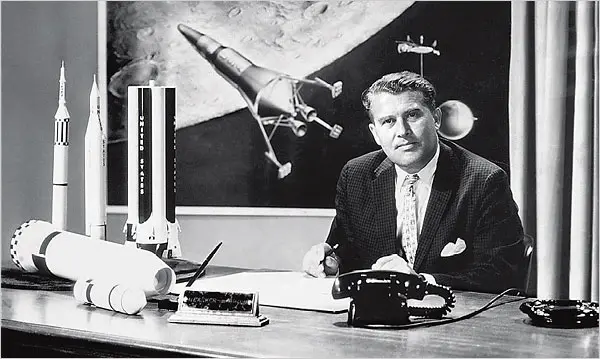Werhner Von Braun was a German-born scientist who is considered to be among the pioneers of rocket and space research.
Early life
Wernher Magnus Maximilian Freiherr von Braun was born on March 23, 1912 in Wirsitiz, Germany. He was one of three sons to Magnus Freiherr von Braun and Emmy von Quistorp. His father Magnus served as a minister of agriculture in the government of Germany at the time, while his mothers ancestry could be traced back to multiple royal families from all over the Europe. Following the end of WWI, Wirsitiz became an integrated part of Poland which made the most of German population move to Germany. Among them was the family of Werhner Von Braun. Werhners interest in rocket science was evident at early age when he was arrested for causing major public disruption when he detonated a toy wagon that he attached to a number of fireworks. This incident was inspired by speed records achieved by Max Valier and Fritz von Opel in their rocket-propelled cars.
Education
In 1925, von Braun attended Ettersburg Castle boarding school near Weimar. Werhner had trouble with natural sciences such as physics and mathematics at that school. It was only after he transferred to Hermann-Lietz-Internat that Werhner got interested in physics and mathematics by acquiring a copy of Die Rakete zu den Planetenraumen (By Rocket into Interplanetary Space). This book woke up his imagination and ever since it was his goal to pursue rocket engineering. In 1930 Werhner enrolled into University of Berlin, there he became a member of Verein für Raumschiffahrt (VfR, the “Spaceflight Society”). It was trough this membership that Werhner got to assist Willy Ley in solid rocket fuel testing. Werhner also attended ETH Zurich.
Achievements
During the Second World War Braun began working on a secret weapon that would combine his life long passion with German war effort. V2 was a 45 feet long, liquid-fuelled rocket that carried a one ton warhead, and was capable of supersonic speed on altitudes of over 8000 meters. The V2 Rocket was first deployed in September, 1944. During the war, there were over 5000 V2 rockets fired on Great Britain. Intriguingly only one fifth of those rockets ever reached their target. These rockets killed 2,724 people and badly injured 6,000. These attacks continued until allied forces managed to capture the launch sites during their advance to Berlin. In last months of war, Werhner realized that the war is lost and he and most of his staff decided to surrender to American forces. In United States, Braun became technical director of the US Army’s Ballistic Missile Agency at Huntsville, Alabama and was chiefly responsible for the manufacture and successful launching of Redstone, Jupiter-C, Juno and Pershing missiles. In 1960 Braun became director of the Marshall Space Flight Center where he developed the Saturn rocket that helped the United States to land on the moon in 1969.
Later life
On June 16, 1977, Wernher von Braun died due to cancer in Alexandria, Virginia, at the age of 65. He was buried at the Ivy Hill Cemetery in Alexandria, Virginia.
Werner Von Braun quotes
“I have learned to use the word “impossible” with the greatest caution.”
“Research is what I’m doing when I don’t know what I’m doing.”

